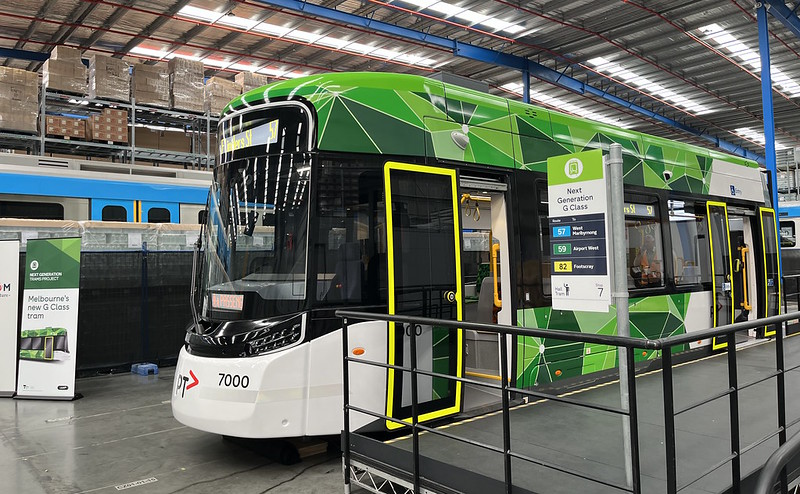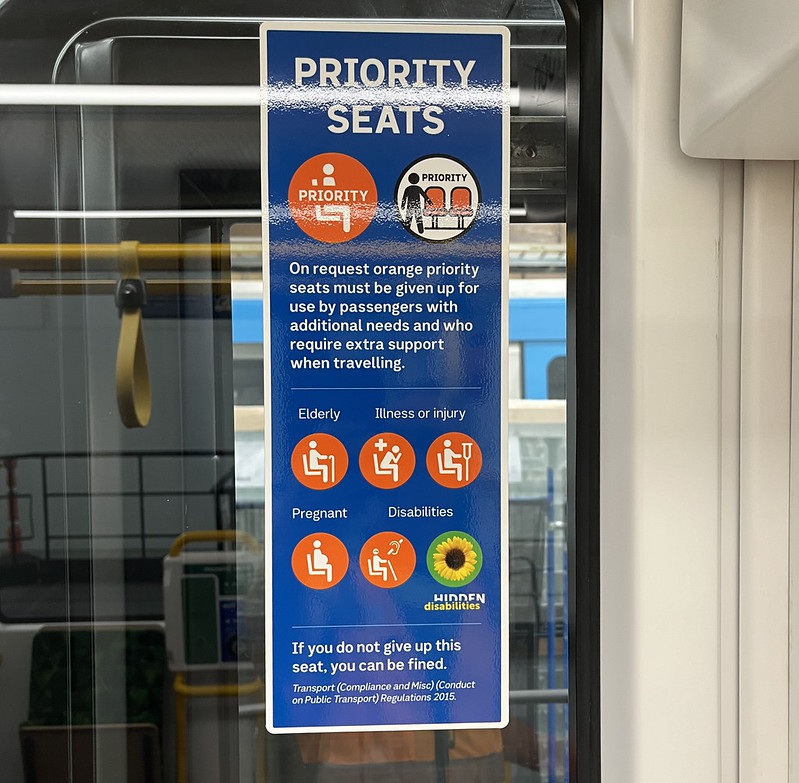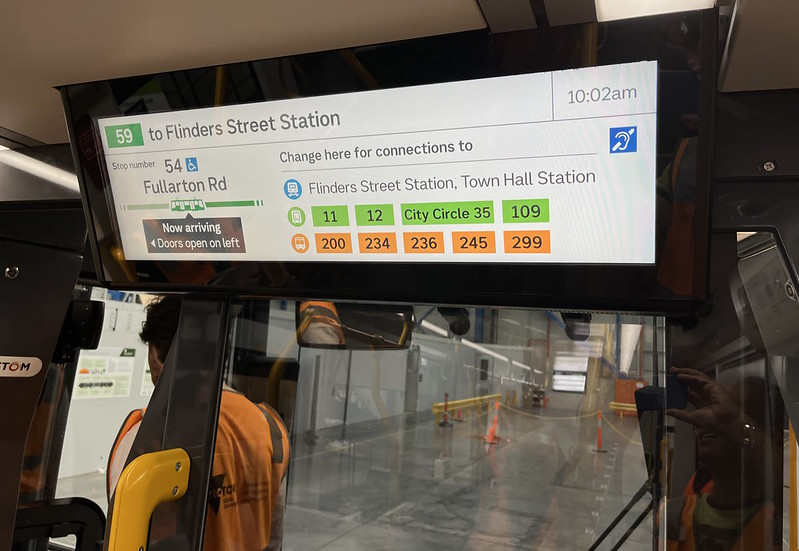I got to see a mock-up of the new G Class tram last week.
Why G Class instead of F Class? The official word is it was to align with the fleet numbers, given G is the 7th letter, and the trams will be numbered from 7001.
Why are they out of whack? The B Class is 2xxx, C Class is 3xxx, etc. It seems to have happened because they skipped 4xxx. Why? I’m not sure.
The G Class mock-up, like the train mock-ups recently built, represents the front section of the tram up to the first articulation. Apparently they’re going to add a bit more to the mock-up to make it slightly longer.
The trams will be 25 metres long, with capacity for 150 people. This makes it slightly longer than the B Class, but shorter than the E Class. The reason it’s shorter is to enable it to run on any line on the Melbourne tram network, whereas the Es are restricted to specific lines.
However it will be possible to extend the trams later, with an additional module in the middle.
The government has committed to an order of 100 trams, with an accelerated rate (compared to previous rollouts) of up to 30 per year.
This will help upgrade more of the fleet to low floors, with the new trams replacing Z class trams. They’ll be initially deployed on routes 57, 59 and 82, so will also replace Bs on the 59 – with those no doubt moving to other depots currently using Zs such as Malvern and Glen Huntly.
Eventually the Gs will also go to other depots around the network.
They’ll have on-board batteries to reduce energy usage, meaning they can be rolled-out more quickly without the need for so many power upgrades, such as all the substations being built around the place.
The destination display on the exterior of the tram isn’t a finalised design – it’s not even electronic at the moment, just pretend. Just as well as it wasn’t very readable in bright light. Hopefully they’ll avoid the issues with the E Class and their rapidly scrolling, flickery displays.
There’ll be displays inside similar to those seen on other new trams in the fleet, and showing tram route and interchange information.
The cab has been designed to improve crash worthiness, as well as driver sight lines.
Internally the layout is similar in some ways to the E class, but the inclusion of doors at the ends of the tram is a big improvement that will help passenger circulation.
The “egg beater” design for the big grab handle near the doors is apparently a newish concept used in Brussels, and improves visibility along the tram. Clever.
I assumed the wooden-backed seats were just part of the mock-up, but it seems it’s an option provided by the manufacturer, which DTP is considering. I wonder how easy it would be to keep clean.
Overall the design looks good to me.
One caveat: the feeling of light and space is likely to be undermined as soon as they start putting All-Over Advertising on these trams, effectively blocking most windows.
There’s no need for this. PT networks and advertisers can work around it if they try. I’d love to see blocking the windows banned on trams and buses, just as it is for trains.
Thanks to the Department of Transport and Planning for arranging this visit for the PTUA Committee. They’re getting other stakeholders through to review the design.
PS. Thanks to all those who attended the PTUA AGM last night! Interesting presentation from the new ticketing operator. Thanks also to Tony as MC, Jarred and especially Michael for managing the event.










18 replies on “G Class tram mock-up”
Thanks for the update. A few press releases have circulated about the design. Apparently, the trams will also include additional safety technology including some crash detection features. Keen to see how this works on the trams as Tram to Vehicle crashes are a high frequency occurrence. Hopefully they also include Tram to Pedestrian and Cyclist detection.
The new Brisbane Metro articulated buses included ADAS, Blind Spot protection (external cameras) and a driver facing Fatigue Camera.
Love the low floor designs, but not a fan of the narrow walkways between the doors. This really restricts circulation up and down the tram.
@db @danielbowen What's leg room like in the facing seats, as cramped as on the E-class? I don’t like the look of that seat with the wooden board in front, looks very cramped. Will not miss the Z-class trams, but will miss the Bs! V comfy seating on those.
Tim’s question was on Mastodon, relayed back here via the WordPress ActivityPub plugin, which I’m trying out. Not sure why my reply to him there wasn’t also sent back.
Not a brilliant amount of leg room in the facing seats – similar to the C class… which is one reason I prefer to sit elsewhere on the Cs.
Wooden seats are quite widely used in Europe, popular with both operators and passengers as they are easy to keep clean. You’d never believe what crap lurks within those fabric seats! The E seats only have wooden backing though. There’s still fabric padding.
I’m intrigued that the reason for 25 metre trams is so that these can operate all over Melbourne. Exactly what parts of the system can’t take 30 metres trams and for what reason? Never heard of that before.
The narrow aisle looks only about 500 mm wide, but I guess they didn’t give you a dimension. Narrow aisles seem to be a drawback of these Bombardier designs and is an issue that you could pursue with PTV. Two people should be able to pass comfortably in an aisle.
@Tony P
The issue isn’t the length, it’s the power consumption (from what I’ve read). The batteries on the G class will help reduce the peak load on the substations by providing power during acceleration and only taking a lower average to top up throughout a trip. The E-class with no onboard batteries needed extra substations to run at high frequencies.
Not sure why they didn’t order an E class size trams, but given these are replacing Z class trams, the capacity bump will still be significant (112 vs 150) enough.
I’m hoping that the Essendon depot gets retained once Maidstone opens but that seems unlikely. I’d also hope that depots like Glenhuntly and Camberwell also get some. For example, Malvern should replace their Zs with As from Camberwell, who will get G class trams in turn.
30 trams a year is promising, that’s ~3 years worth of production compared to the 10 it took for the E-Class at 10/year. We need that sort of rate to be sustained if we are to replace the remaining As and Bs over the next 15 years.
Thanks for visiting and telling us a bit more about the G Class. I have my own thoughts on why they aren’t called the eff class. The exposed timber just looks so wrong to me. To Tony P., the E Class do not have timber backs, but metal sheets. The metal sometimes ‘pops’ forward or back with acceleration and braking, as I’ve experienced many times. It’s quite annoying.
At most tram depots there are tram storage space issues and longer trams of the same number will be problematic, but As replacing Zs at Malvern won’t be a problem. Still for years though, only half the number Malvern Depot trams will have passenger aircon.
One pleasurable thing to do in Sydney is to ride buses in inner areas where there were once trams. This experience has been thoroughly spoilt by AOA covering the windows of almost every bus. What a disgrace.
@tramlover Mirroring your thoughts on the narrow gangways.
I wonder why Bombardier’s trams in Melbourne (E / G-Class) have particularly narrow gangways. A single person standing in the gangway will block circulation of passengers. On the E-Class, I often see one end of the tram crowded, while the other end has plenty of space.
All of Melbourne’s non-Bombardier low-floor trams and all the other low-floor trams seen elsewhere (e.g. Sydney, Gold Coast) have much wider spacing between seats near the wheels. Two people can pass or stand next to each other.
I’ve heard that the E-Class can be explained because it is technically a 70% low-floor tram from the Flexity Swift series. However, this doesn’t apply to the G-Class. The G-Class is based on the Flexity 2 series, which is 100% low-floor and is the same type of trams Gold Coast’s trams are currently using.
I can confirm that the “egg beater” thing comes from Brussels. However we’ve had this in our T4000 (and maybe T3000) Flexity trams for quite some time. A general thing with Melbourne’s new G class trams is that they’re very similar to the new T3200 & T4200 (also known as TNG) in Brussels, and they come from the same manufacturer. The only major difference, apart from the livery of course, is that the trams ordered for Brussels will ne much longer, the T3200 will be 35 meters in length, and the T4200 will be 45 meters in length. For the moment, only the T3200 have entered service (on tram 51).
@James.P. The Melbourne Cs and Ds and the Sydney, Canberra, Gold Coast and the Alstom trams in Adelaide all have fixed bogies, hence are able to have wider aisles because they don’t have to accommodate bogie-swing. The Es and Gs have narrow aisles because the swivelling bogies need space to turn under the floor on corners.
My observation is that Alstom (Bombardier) is not very accomplished at striking a balance between bogie rotation and aisle width, because other manufacturers, such as Škoda, successfully achieve a wider aisle with swivelling bogies. However, I think Melbourne is going to be stuck with Alstom trams as no other manufacturer will invest in a local factory just for a single contract – unless the government allows imported trams.
@ Andrew Cee. Typo on my part – I meant the G class with wooden seats, not the E class.
If you want to have a bad experience with AOA, try Canberra where it blots out the expansive lake and mountain views and you can’t see anything at night. It’s a plague. In Perth, however, it’s confined to a single discreet panel on the offside, a method that seems to be also used on the new Custom Denning electric buses.
Your comments about substations, is a spin they would like us to think, but there are building a new one on RT59 for the G-Class trams (https://engage.vic.gov.au/essendon-south-substation).
Also I would worry too much about AOA and only now is AOA trickling onto E-Class 10 years after introduction.
The 30 vehicles per year will be under the minimum required to meet the 3032 deadline, there are about 300 High floor trams in service today, less the 30 Z’s rumoured to be withdrawn after the latest timetable update leaves about 270, 270/7=38.5 at which time C & D class will be due for retirement (if they last that long!)
Regrading, Tony P’s comment about where can’t you take a 30m tram, for a start RT82, the end of RT67 (But I would want oner going through Elsternwick shopping centre), RT1 (South end), etc.
And I would guess that Essendon will be retained to house RT59, and the present fleet for RT58 and Maidstone will be the service centre. as it can only stable 60 units
My assumption is the power supply claims are comparing the G Class with the E Class… those required a lot of additional substations to be built.
They might need some to replace As and Zs with Gs, but not as many as if they replaced them with Es.
I seem to recall the E Class can’t go through some of the curves around Caulfield on route 3, and there might be other troublespots.
[…] stops in this area soon is especially important as the new Footscray hospital opens in 2025, and low-floor G-class trams are also expected in service in 2025, starting with this route and others in the […]
These trams overall look really good – a nice upgrade from the existing E Class. It would be good to see what else can be displayed on the internal passenger information displays – such as outside temperature, interruptions to other services across the network and public service announcements.
[…] depot will be home to the new G class trams, which will initially run on routes 82 and 57, both of which pass nearby. The depot will connect to […]
Being in a wheelchair is the g glass tram designed so I can enter the tram from road level not a accessible platform
If so what gradient will the ramp be from road level to tram
@Jay, sorry, I didn’t spot this question until now.
I don’t believe there’s any intention to change the long-running policy of only unassisted boarding. That is, ramps are only for emergency evacuations, not regular use. For normal use, wheelchair users are meant to use level boarding (platform) stops.